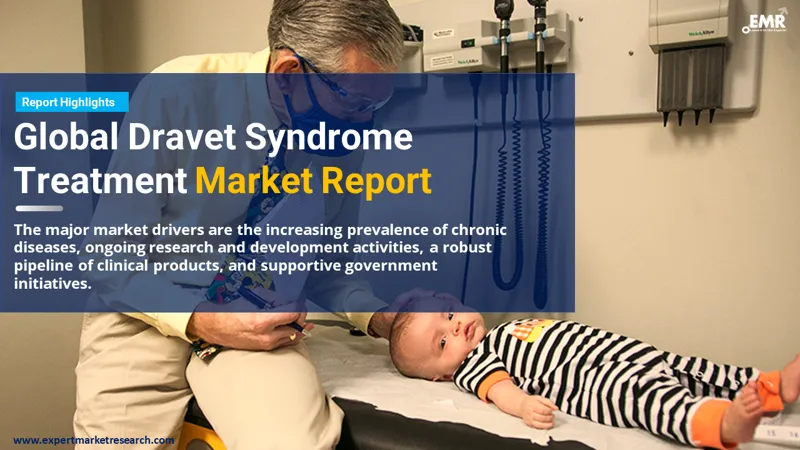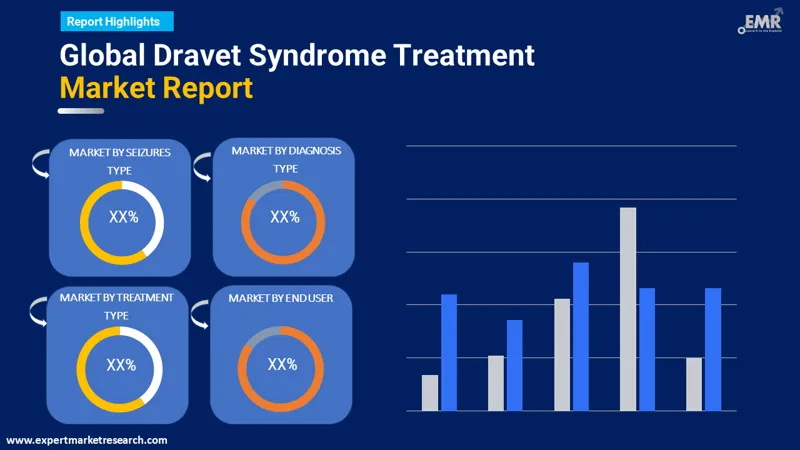
Consumer Insights
Uncover trends and behaviors shaping consumer choices today
Procurement Insights
Optimize your sourcing strategy with key market data
Industry Stats
Stay ahead with the latest trends and market analysis.
The global Dravet syndrome treatment market size attained a value of USD 0.44 Billion in 2025. The market is likely to expand at a CAGR of 10.10% during the forecast period of 2026-2035 to attain a value of USD 1.15 Billion by 2035. The growth of the market is being driven by the rising prevalence of the condition.
Base Year
Historical Period
Forecast Period
Compound Annual Growth Rate
10.1%
Value in USD Billion
2026-2035
*this image is indicative*
Dravet Syndrome, also known as Severe Myoclonic Epilepsy of Infancy (SMEI), is a rare, severe form of epilepsy that starts in infancy. It is a genetic disorder caused by mutations in the SCN1A gene. There is currently no cure for Dravet Syndrome, but there are various treatment options available that aim to manage the symptoms of the disease. The report covers the market for Dravet Syndrome treatment, including drugs and therapies, and provides a detailed analysis of the market size, growth, and trends.

Read more about this report - REQUEST FREE SAMPLE COPY IN PDF
Dravet Syndrome, also known as Severe Myoclonic Epilepsy of Infancy (SMEI), is a rare genetic disorder that affects approximately one in every 15,700 individuals worldwide. The disease typically begins in infancy, with infants experiencing seizures that are often prolonged and difficult to manage. As the child grows, the seizures may become more frequent and severe, and may be accompanied by cognitive and behavioral problems.
The prevalence of Dravet Syndrome varies by region, but it is estimated to affect approximately one in every 20,000 to 40,000 individuals worldwide. It is more common in males than females, with a male-to-female ratio of approximately 1.5:1.
The treatment options for Dravet Syndrome are focused on managing the symptoms of the disease and improving the quality of life of patients. The primary treatment is medication, specifically anticonvulsants such as clobazam, valproate, and stiripentol. These drugs work by stabilizing the electrical activity in the brain, reducing the frequency and severity of seizures. Benzodiazepines may also be used in combination with anticonvulsants to manage acute seizures.

Read more about this report - REQUEST FREE SAMPLE COPY IN PDF
The market can be categorised into seizure type, diagnosis type, treatment type, end user, and major region.
Market Breakup by Seizures Type
Market Breakup by Diagnosis Type
Market Breakup by Treatment Type
Market Breakup by End User
Market Breakup by Region
The global Dravet syndrome treatment market is expected to grow at a significant rate during the forecast period of 2026-2035. The increasing prevalence of the disease, rising awareness, and growing investment in research and development activities are the key drivers of the market. North America dominates the market, followed by Europe and Asia Pacific. The leading players in the market are focusing on the development of new drugs and therapies and adopting various strategies to strengthen their position in the market.
North America dominates the Dravet Syndrome treatment market, followed by Europe and Asia Pacific. The high prevalence of Dravet Syndrome in North America, coupled with the favorable reimbursement policies, is driving the growth of the market in the region. Europe is also a significant market for Dravet Syndrome treatment, with the presence of key players and increasing investment in research and development activities. The Asia Pacific region is expected to grow at the highest CAGR during the forecast period, owing to the increasing awareness about the disease and the rising healthcare expenditure in the region.
The report gives an in-depth analysis of the key players involved in the Dravet Syndrome Treatment market, sponsors manufacturing the drugs, and putting them through trials to get FDA approvals. The companies included in the market are as follows:




*While we strive to always give you current and accurate information, the numbers depicted on the website are indicative and may differ from the actual numbers in the main report. At Expert Market Research, we aim to bring you the latest insights and trends in the market. Using our analyses and forecasts, stakeholders can understand the market dynamics, navigate challenges, and capitalize on opportunities to make data-driven strategic decisions.*
Get in touch with us for a customized solution tailored to your unique requirements and save upto 35%!
The market attained a value of about USD 0.44 Billion in 2025.
The market is likely to expand at a CAGR of 10.10% during the forecast period of 2026-2035 to attain a value of USD 1.15 Billion by 2035.
The market is primarily driven by the rising prevalence of chronic disorders, increasing research and developmental activities, robust clinical products pipeline and favouring government initiatives.
North America is anticipated to hold a maximum share of the market during the forecast period.
Based on the seizure type, the market is segmented into myoclonic seizures, atonic seizures, partial seizures, absence seizures, tonic seizures, photosensitive seizures, and others.
Based on the diagnosis type, the market is bifurcated into Magnetic Resonance Imaging (MRI), electroencephalography, Scn1 A testing, and others.
Based on the end users, the market is divided into pharmaceutical companies, hospitals, diagnostic laboratories, academic & research institutes, and others.
The different regions in the market are North America, Europe, Asia Pacific, Latin America and the Middle East and Africa.
The key companies involved in the market are Biocodex, Biscayne Neurotherapeutics (Supernus Pharmaceuticals, Inc.), Cyberonics (LivaNova PLC), Epygenix Therapeutics, Inc., GW Pharmaceuticals (Jazz Pharmaceuticals, Inc.), OPKO Health, Inc., Ovid Therapeutics, PTC Therapeutics, Encoded Therapeutics, Inc., Zogenix (UCB S.A., Belgium), and Takeda Pharmaceutical Company Limited, among others.
Explore our key highlights of the report and gain a concise overview of key findings, trends, and actionable insights that will empower your strategic decisions.
| REPORT FEATURES | DETAILS |
| Base Year | 2025 |
| Historical Period | 2019-2025 |
| Forecast Period | 2026-2035 |
| Scope of the Report |
Historical and Forecast Trends, Industry Drivers and Constraints, Historical and Forecast Market Analysis by Segment:
|
| Breakup by Seizures Type |
|
| Breakup by Diagnosis Type |
|
| Breakup by Treatment Type |
|
| Breakup by End User |
|
| Breakup by Region |
|
| Market Dynamics |
|
|
Supplier Landscape |
|
| Companies Covered |
|
Single User License
One User
USD 5,499
USD 4,949
tax inclusive*
Datasheet
One User
USD 3,299
USD 2,969
tax inclusive*
Five User License
Five User
USD 6,999
USD 5,949
tax inclusive*
Corporate License
Unlimited Users
USD 8,199
USD 6,969
tax inclusive*
*Please note that the prices mentioned below are starting prices for each bundle type. Kindly contact our team for further details.*
Flash Bundle
Small Business Bundle
Growth Bundle
Enterprise Bundle
*Please note that the prices mentioned below are starting prices for each bundle type. Kindly contact our team for further details.*
Flash Bundle
Number of Reports: 3
20%
tax inclusive*
Small Business Bundle
Number of Reports: 5
25%
tax inclusive*
Growth Bundle
Number of Reports: 8
30%
tax inclusive*
Enterprise Bundle
Number of Reports: 10
35%
tax inclusive*
How To Order

Select License Type
Choose the right license for your needs and access rights.

Click on ‘Buy Now’
Add the report to your cart with one click and proceed to register.

Select Mode of Payment
Choose a payment option for a secure checkout. You will be redirected accordingly.
Gain insights to stay ahead and seize opportunities.

Get insights & trends for a competitive edge.

Track prices with detailed trend reports.

Analyse trade data for supply chain insights.

Leverage cost reports for smart savings

Enhance supply chain with partnerships.

Connect For More Information
Our expert team of analysts will offer full support and resolve any queries regarding the report, before and after the purchase.
Our expert team of analysts will offer full support and resolve any queries regarding the report, before and after the purchase.
We employ meticulous research methods, blending advanced analytics and expert insights to deliver accurate, actionable industry intelligence, staying ahead of competitors.
Our skilled analysts offer unparalleled competitive advantage with detailed insights on current and emerging markets, ensuring your strategic edge.
We offer an in-depth yet simplified presentation of industry insights and analysis to meet your specific requirements effectively.
Share